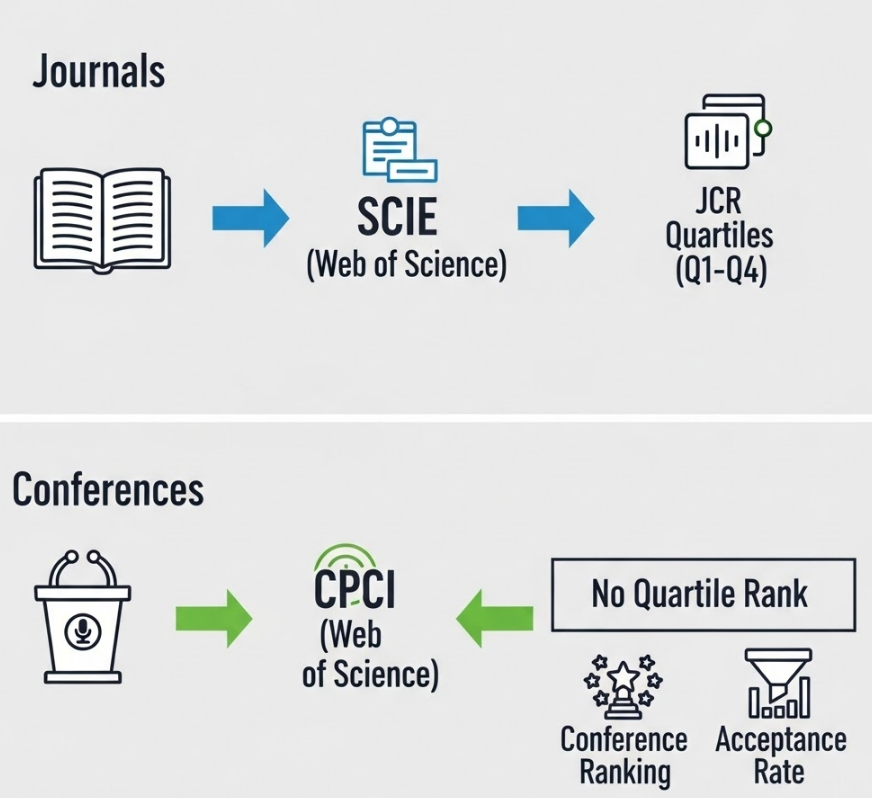

123 views||Release time: Oct 10, 2025
A frequent question among researchers is, "What journal quartile, or zone , does an SCI-indexed conference paper belong to?" This question stems from a common confusion between how journals and conferences are indexed and ranked.

The direct answer is simple: Conference papers are not assigned journal quartiles. The quartile system (Q1, Q2, Q3, Q4) is a ranking metric applied exclusively to journals, not to conference proceedings.
This guide will explain why this is the case, how conference papers are indexed by Web of Science, and the correct way to assess the quality and prestige of a conference.
To clear up the confusion, it's essential to understand the different indexing and ranking systems.
What are Journal Quartiles? (JCR Ranking) Journal Quartiles are rankings given to academic journals based on their Journal Impact Factor (JIF). This data is published annually in the Journal Citation Reports (JCR) by Clarivate.
Journals in a specific subject category are ranked by their Impact Factor.
This ranked list is then divided into four equal parts, or quartiles:
Q1: The top 25% of journals in the category (highest impact).
Q2: The next 25% (25-50%).
Q3: The next 25% (50-75%).
Q4: The bottom 25% (75-100%). This entire system is designed for, and only applicable to, journals.
How are Conference Papers Indexed? (CPCI in Web of Science) Reputable conference papers are also indexed by Clarivate's Web of Science (WoS) Core Collection, but they are included in a different database called the Conference Proceedings Citation Index (CPCI).
A paper indexed in CPCI is considered "indexed by Web of Science."
However, the CPCI database does not use a quartile ranking system.
Therefore, a "conference SCI paper" is a misnomer. A paper is either a journal article indexed in SCIE (which has a quartile) or a conference paper indexed in CPCI (which does not).
The main reason for this confusion is the common practice of publishing conference papers in journals. This happens in two main ways:
Journal Special Issues: This is the most common scenario. The organizers of a high-quality conference will partner with a regular, SCI-indexed journal. The best papers from the conference are invited to be significantly extended and then submitted to a "Special Issue" of that journal. If accepted after another round of rigorous peer review, the final publication is an official journal paper. As such, it inherits the prestige and the quartile ranking (Q1-Q4) of the journal it is published in.
Indexed Proceedings Series: Some conference proceedings are published as part of a series (e.g., from publishers like IEEE or Springer) that is indexed in the Web of Science Core Collection (in CPCI). While this gives the paper a WoS accession number, the series itself is not a journal and does not have a JCR quartile rank.
If you can't use journal quartiles, how do you determine if a conference is prestigious? You should use metrics specific to the conference world:
Conference Rankings: In some fields, like computer science, there are well-established conference rankings (e.g., CORE ranking, which uses A*, A, B, C tiers). These are the "quartiles" of the conference world.
Reputation and "Flagship" Status: Is the conference considered the "flagship" event in its specific sub-field? Ask your supervisor and senior colleagues which conferences "matter."
Publisher: Are the proceedings published by a reputable academic press like IEEE, ACM, Springer, Elsevier, etc.?
Indexing History: Have the proceedings from previous years been consistently indexed in databases like CPCI, Scopus, and EI Compendex?
Sponsorship: Is the conference sponsored by a major international professional society (e.g., IEEE, ACM)?
Acceptance Rate: Top-tier, highly reputable conferences often have very low acceptance rates (e.g., below 25%).
Conclusion
Stop trying to apply journal quartiles to conferences. They are different publication types with different evaluation systems. A paper from a top-tier, highly-ranked conference (like NeurIPS or CVPR in computer science) can be far more valuable to your career than a paper in a Q3 or Q4 journal.
Judge a conference by its own standards: its reputation in the field, its publisher, its indexing history, and its acceptance rate. This will give you a far more accurate measure of its quality and relevance to your work.